BN606 Mental Health Nursing: Adolescent Mental Health, Tidal Model
VerifiedAdded on 2023/04/25
|12
|3491
|486
Essay
AI Summary
This essay explores mental health nursing in New Zealand, focusing on the critical issue of adolescent mental health. It highlights the increasing prevalence of mental health problems among young people in New Zealand, referencing statistics from the Ministry of Health. The essay discusses the lifespan theory of development, particularly the challenges adolescents face during this period, such as identity crisis and social inclusion. It also explains the Tidal Model of recovery, emphasizing patient empowerment and collaborative care. Furthermore, the essay outlines governmental strategies and initiatives aimed at improving mental health services and social inclusion for mentally ill youths in New Zealand, including the person-centered approach, resiliency and recovery methods, and early intervention programs. Finally, it touches on nursing practices that support mental health patients, highlighting the importance of building trust and understanding with adolescent patients to facilitate their recovery.
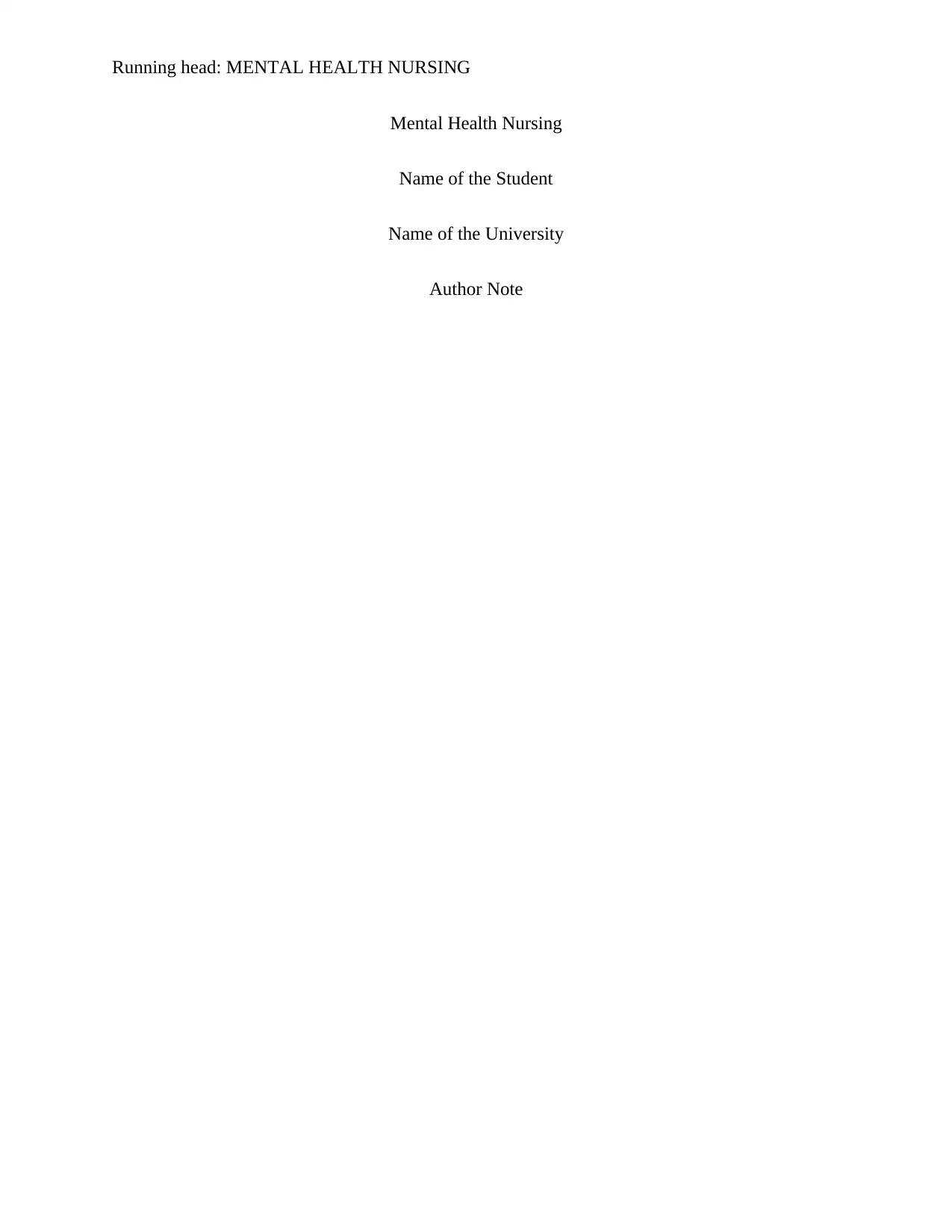
Running head: MENTAL HEALTH NURSING
Mental Health Nursing
Name of the Student
Name of the University
Author Note
Mental Health Nursing
Name of the Student
Name of the University
Author Note
Paraphrase This Document
Need a fresh take? Get an instant paraphrase of this document with our AI Paraphraser
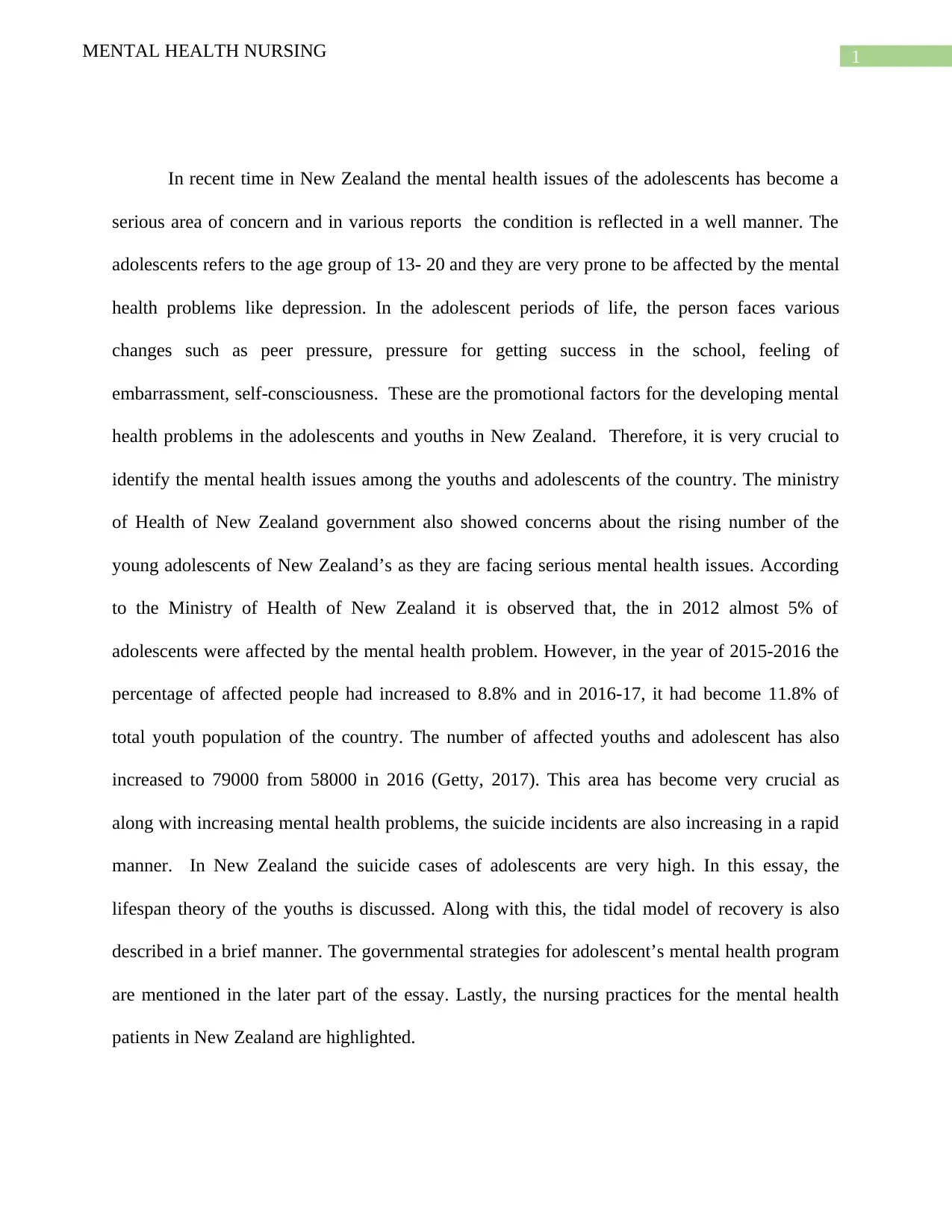
1MENTAL HEALTH NURSING
In recent time in New Zealand the mental health issues of the adolescents has become a
serious area of concern and in various reports the condition is reflected in a well manner. The
adolescents refers to the age group of 13- 20 and they are very prone to be affected by the mental
health problems like depression. In the adolescent periods of life, the person faces various
changes such as peer pressure, pressure for getting success in the school, feeling of
embarrassment, self-consciousness. These are the promotional factors for the developing mental
health problems in the adolescents and youths in New Zealand. Therefore, it is very crucial to
identify the mental health issues among the youths and adolescents of the country. The ministry
of Health of New Zealand government also showed concerns about the rising number of the
young adolescents of New Zealand’s as they are facing serious mental health issues. According
to the Ministry of Health of New Zealand it is observed that, the in 2012 almost 5% of
adolescents were affected by the mental health problem. However, in the year of 2015-2016 the
percentage of affected people had increased to 8.8% and in 2016-17, it had become 11.8% of
total youth population of the country. The number of affected youths and adolescent has also
increased to 79000 from 58000 in 2016 (Getty, 2017). This area has become very crucial as
along with increasing mental health problems, the suicide incidents are also increasing in a rapid
manner. In New Zealand the suicide cases of adolescents are very high. In this essay, the
lifespan theory of the youths is discussed. Along with this, the tidal model of recovery is also
described in a brief manner. The governmental strategies for adolescent’s mental health program
are mentioned in the later part of the essay. Lastly, the nursing practices for the mental health
patients in New Zealand are highlighted.
In recent time in New Zealand the mental health issues of the adolescents has become a
serious area of concern and in various reports the condition is reflected in a well manner. The
adolescents refers to the age group of 13- 20 and they are very prone to be affected by the mental
health problems like depression. In the adolescent periods of life, the person faces various
changes such as peer pressure, pressure for getting success in the school, feeling of
embarrassment, self-consciousness. These are the promotional factors for the developing mental
health problems in the adolescents and youths in New Zealand. Therefore, it is very crucial to
identify the mental health issues among the youths and adolescents of the country. The ministry
of Health of New Zealand government also showed concerns about the rising number of the
young adolescents of New Zealand’s as they are facing serious mental health issues. According
to the Ministry of Health of New Zealand it is observed that, the in 2012 almost 5% of
adolescents were affected by the mental health problem. However, in the year of 2015-2016 the
percentage of affected people had increased to 8.8% and in 2016-17, it had become 11.8% of
total youth population of the country. The number of affected youths and adolescent has also
increased to 79000 from 58000 in 2016 (Getty, 2017). This area has become very crucial as
along with increasing mental health problems, the suicide incidents are also increasing in a rapid
manner. In New Zealand the suicide cases of adolescents are very high. In this essay, the
lifespan theory of the youths is discussed. Along with this, the tidal model of recovery is also
described in a brief manner. The governmental strategies for adolescent’s mental health program
are mentioned in the later part of the essay. Lastly, the nursing practices for the mental health
patients in New Zealand are highlighted.
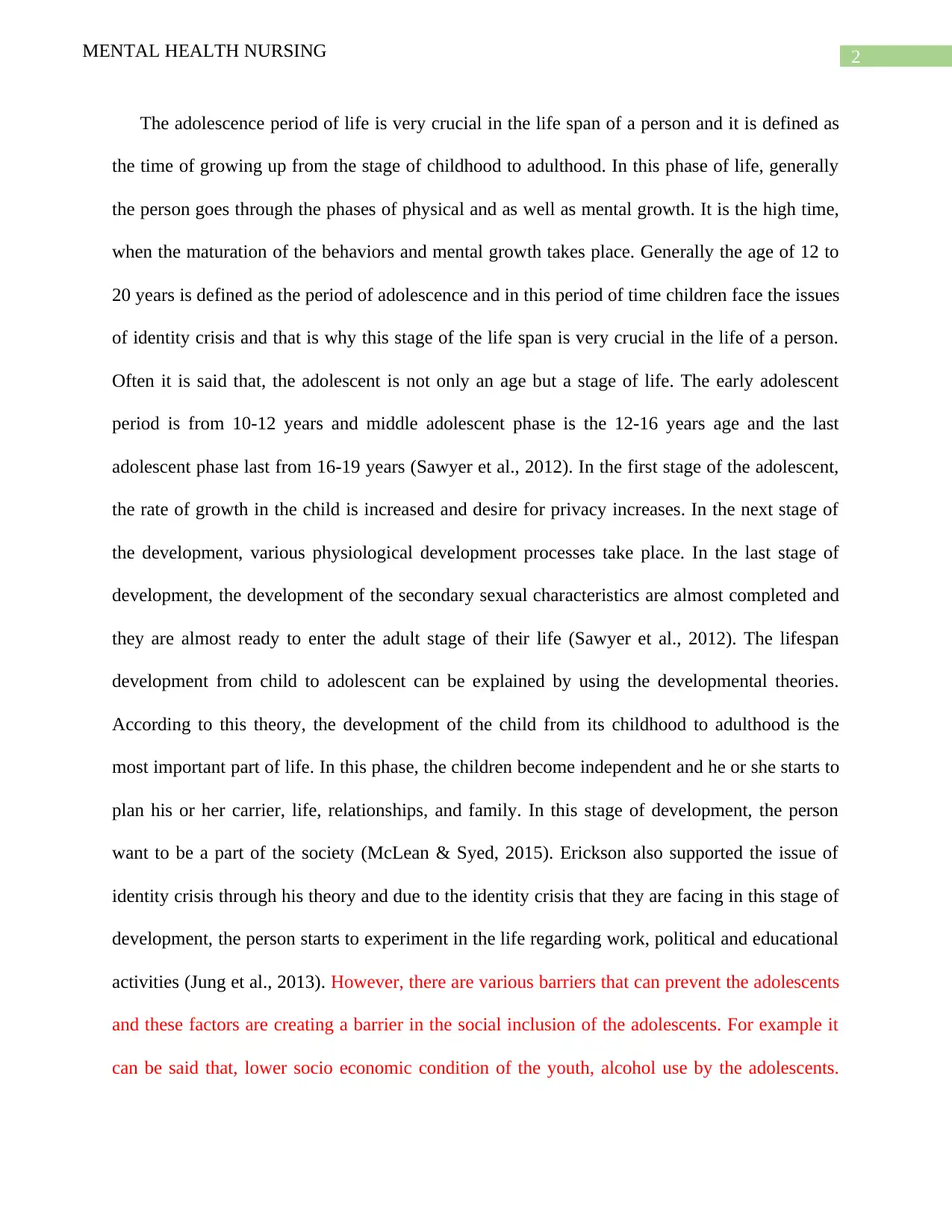
2MENTAL HEALTH NURSING
The adolescence period of life is very crucial in the life span of a person and it is defined as
the time of growing up from the stage of childhood to adulthood. In this phase of life, generally
the person goes through the phases of physical and as well as mental growth. It is the high time,
when the maturation of the behaviors and mental growth takes place. Generally the age of 12 to
20 years is defined as the period of adolescence and in this period of time children face the issues
of identity crisis and that is why this stage of the life span is very crucial in the life of a person.
Often it is said that, the adolescent is not only an age but a stage of life. The early adolescent
period is from 10-12 years and middle adolescent phase is the 12-16 years age and the last
adolescent phase last from 16-19 years (Sawyer et al., 2012). In the first stage of the adolescent,
the rate of growth in the child is increased and desire for privacy increases. In the next stage of
the development, various physiological development processes take place. In the last stage of
development, the development of the secondary sexual characteristics are almost completed and
they are almost ready to enter the adult stage of their life (Sawyer et al., 2012). The lifespan
development from child to adolescent can be explained by using the developmental theories.
According to this theory, the development of the child from its childhood to adulthood is the
most important part of life. In this phase, the children become independent and he or she starts to
plan his or her carrier, life, relationships, and family. In this stage of development, the person
want to be a part of the society (McLean & Syed, 2015). Erickson also supported the issue of
identity crisis through his theory and due to the identity crisis that they are facing in this stage of
development, the person starts to experiment in the life regarding work, political and educational
activities (Jung et al., 2013). However, there are various barriers that can prevent the adolescents
and these factors are creating a barrier in the social inclusion of the adolescents. For example it
can be said that, lower socio economic condition of the youth, alcohol use by the adolescents.
The adolescence period of life is very crucial in the life span of a person and it is defined as
the time of growing up from the stage of childhood to adulthood. In this phase of life, generally
the person goes through the phases of physical and as well as mental growth. It is the high time,
when the maturation of the behaviors and mental growth takes place. Generally the age of 12 to
20 years is defined as the period of adolescence and in this period of time children face the issues
of identity crisis and that is why this stage of the life span is very crucial in the life of a person.
Often it is said that, the adolescent is not only an age but a stage of life. The early adolescent
period is from 10-12 years and middle adolescent phase is the 12-16 years age and the last
adolescent phase last from 16-19 years (Sawyer et al., 2012). In the first stage of the adolescent,
the rate of growth in the child is increased and desire for privacy increases. In the next stage of
the development, various physiological development processes take place. In the last stage of
development, the development of the secondary sexual characteristics are almost completed and
they are almost ready to enter the adult stage of their life (Sawyer et al., 2012). The lifespan
development from child to adolescent can be explained by using the developmental theories.
According to this theory, the development of the child from its childhood to adulthood is the
most important part of life. In this phase, the children become independent and he or she starts to
plan his or her carrier, life, relationships, and family. In this stage of development, the person
want to be a part of the society (McLean & Syed, 2015). Erickson also supported the issue of
identity crisis through his theory and due to the identity crisis that they are facing in this stage of
development, the person starts to experiment in the life regarding work, political and educational
activities (Jung et al., 2013). However, there are various barriers that can prevent the adolescents
and these factors are creating a barrier in the social inclusion of the adolescents. For example it
can be said that, lower socio economic condition of the youth, alcohol use by the adolescents.
⊘ This is a preview!⊘
Do you want full access?
Subscribe today to unlock all pages.

Trusted by 1+ million students worldwide
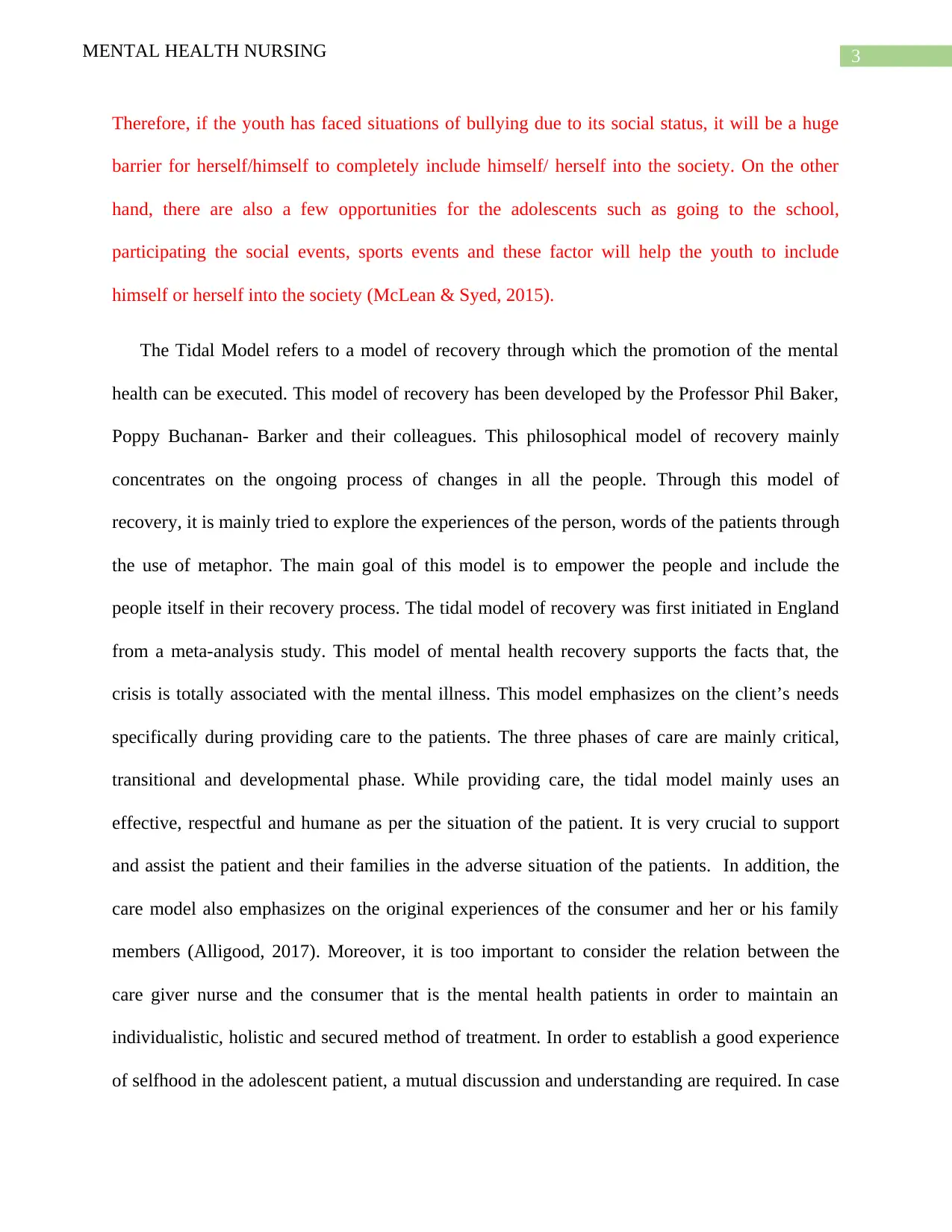
3MENTAL HEALTH NURSING
Therefore, if the youth has faced situations of bullying due to its social status, it will be a huge
barrier for herself/himself to completely include himself/ herself into the society. On the other
hand, there are also a few opportunities for the adolescents such as going to the school,
participating the social events, sports events and these factor will help the youth to include
himself or herself into the society (McLean & Syed, 2015).
The Tidal Model refers to a model of recovery through which the promotion of the mental
health can be executed. This model of recovery has been developed by the Professor Phil Baker,
Poppy Buchanan- Barker and their colleagues. This philosophical model of recovery mainly
concentrates on the ongoing process of changes in all the people. Through this model of
recovery, it is mainly tried to explore the experiences of the person, words of the patients through
the use of metaphor. The main goal of this model is to empower the people and include the
people itself in their recovery process. The tidal model of recovery was first initiated in England
from a meta-analysis study. This model of mental health recovery supports the facts that, the
crisis is totally associated with the mental illness. This model emphasizes on the client’s needs
specifically during providing care to the patients. The three phases of care are mainly critical,
transitional and developmental phase. While providing care, the tidal model mainly uses an
effective, respectful and humane as per the situation of the patient. It is very crucial to support
and assist the patient and their families in the adverse situation of the patients. In addition, the
care model also emphasizes on the original experiences of the consumer and her or his family
members (Alligood, 2017). Moreover, it is too important to consider the relation between the
care giver nurse and the consumer that is the mental health patients in order to maintain an
individualistic, holistic and secured method of treatment. In order to establish a good experience
of selfhood in the adolescent patient, a mutual discussion and understanding are required. In case
Therefore, if the youth has faced situations of bullying due to its social status, it will be a huge
barrier for herself/himself to completely include himself/ herself into the society. On the other
hand, there are also a few opportunities for the adolescents such as going to the school,
participating the social events, sports events and these factor will help the youth to include
himself or herself into the society (McLean & Syed, 2015).
The Tidal Model refers to a model of recovery through which the promotion of the mental
health can be executed. This model of recovery has been developed by the Professor Phil Baker,
Poppy Buchanan- Barker and their colleagues. This philosophical model of recovery mainly
concentrates on the ongoing process of changes in all the people. Through this model of
recovery, it is mainly tried to explore the experiences of the person, words of the patients through
the use of metaphor. The main goal of this model is to empower the people and include the
people itself in their recovery process. The tidal model of recovery was first initiated in England
from a meta-analysis study. This model of mental health recovery supports the facts that, the
crisis is totally associated with the mental illness. This model emphasizes on the client’s needs
specifically during providing care to the patients. The three phases of care are mainly critical,
transitional and developmental phase. While providing care, the tidal model mainly uses an
effective, respectful and humane as per the situation of the patient. It is very crucial to support
and assist the patient and their families in the adverse situation of the patients. In addition, the
care model also emphasizes on the original experiences of the consumer and her or his family
members (Alligood, 2017). Moreover, it is too important to consider the relation between the
care giver nurse and the consumer that is the mental health patients in order to maintain an
individualistic, holistic and secured method of treatment. In order to establish a good experience
of selfhood in the adolescent patient, a mutual discussion and understanding are required. In case
Paraphrase This Document
Need a fresh take? Get an instant paraphrase of this document with our AI Paraphraser
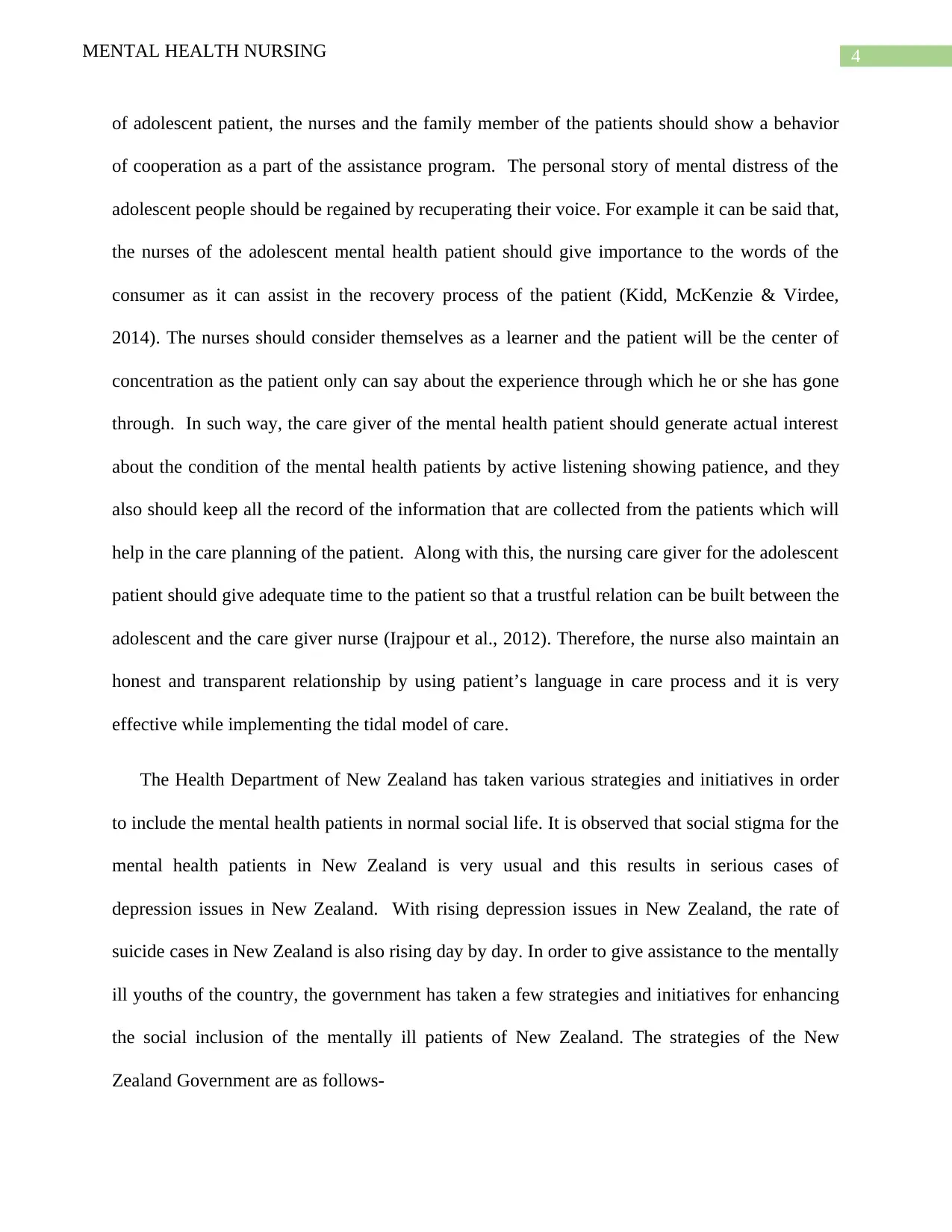
4MENTAL HEALTH NURSING
of adolescent patient, the nurses and the family member of the patients should show a behavior
of cooperation as a part of the assistance program. The personal story of mental distress of the
adolescent people should be regained by recuperating their voice. For example it can be said that,
the nurses of the adolescent mental health patient should give importance to the words of the
consumer as it can assist in the recovery process of the patient (Kidd, McKenzie & Virdee,
2014). The nurses should consider themselves as a learner and the patient will be the center of
concentration as the patient only can say about the experience through which he or she has gone
through. In such way, the care giver of the mental health patient should generate actual interest
about the condition of the mental health patients by active listening showing patience, and they
also should keep all the record of the information that are collected from the patients which will
help in the care planning of the patient. Along with this, the nursing care giver for the adolescent
patient should give adequate time to the patient so that a trustful relation can be built between the
adolescent and the care giver nurse (Irajpour et al., 2012). Therefore, the nurse also maintain an
honest and transparent relationship by using patient’s language in care process and it is very
effective while implementing the tidal model of care.
The Health Department of New Zealand has taken various strategies and initiatives in order
to include the mental health patients in normal social life. It is observed that social stigma for the
mental health patients in New Zealand is very usual and this results in serious cases of
depression issues in New Zealand. With rising depression issues in New Zealand, the rate of
suicide cases in New Zealand is also rising day by day. In order to give assistance to the mentally
ill youths of the country, the government has taken a few strategies and initiatives for enhancing
the social inclusion of the mentally ill patients of New Zealand. The strategies of the New
Zealand Government are as follows-
of adolescent patient, the nurses and the family member of the patients should show a behavior
of cooperation as a part of the assistance program. The personal story of mental distress of the
adolescent people should be regained by recuperating their voice. For example it can be said that,
the nurses of the adolescent mental health patient should give importance to the words of the
consumer as it can assist in the recovery process of the patient (Kidd, McKenzie & Virdee,
2014). The nurses should consider themselves as a learner and the patient will be the center of
concentration as the patient only can say about the experience through which he or she has gone
through. In such way, the care giver of the mental health patient should generate actual interest
about the condition of the mental health patients by active listening showing patience, and they
also should keep all the record of the information that are collected from the patients which will
help in the care planning of the patient. Along with this, the nursing care giver for the adolescent
patient should give adequate time to the patient so that a trustful relation can be built between the
adolescent and the care giver nurse (Irajpour et al., 2012). Therefore, the nurse also maintain an
honest and transparent relationship by using patient’s language in care process and it is very
effective while implementing the tidal model of care.
The Health Department of New Zealand has taken various strategies and initiatives in order
to include the mental health patients in normal social life. It is observed that social stigma for the
mental health patients in New Zealand is very usual and this results in serious cases of
depression issues in New Zealand. With rising depression issues in New Zealand, the rate of
suicide cases in New Zealand is also rising day by day. In order to give assistance to the mentally
ill youths of the country, the government has taken a few strategies and initiatives for enhancing
the social inclusion of the mentally ill patients of New Zealand. The strategies of the New
Zealand Government are as follows-
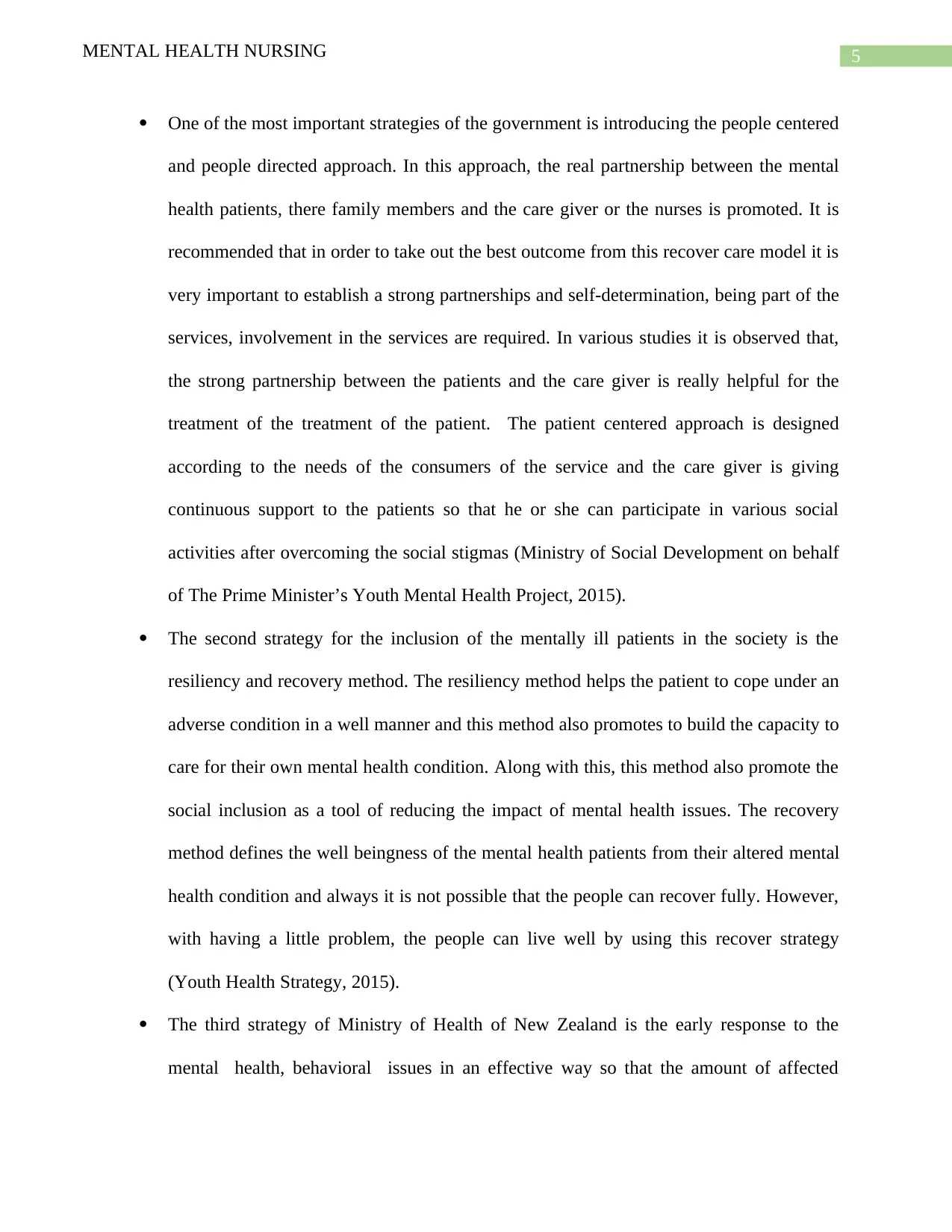
5MENTAL HEALTH NURSING
One of the most important strategies of the government is introducing the people centered
and people directed approach. In this approach, the real partnership between the mental
health patients, there family members and the care giver or the nurses is promoted. It is
recommended that in order to take out the best outcome from this recover care model it is
very important to establish a strong partnerships and self-determination, being part of the
services, involvement in the services are required. In various studies it is observed that,
the strong partnership between the patients and the care giver is really helpful for the
treatment of the treatment of the patient. The patient centered approach is designed
according to the needs of the consumers of the service and the care giver is giving
continuous support to the patients so that he or she can participate in various social
activities after overcoming the social stigmas (Ministry of Social Development on behalf
of The Prime Minister’s Youth Mental Health Project, 2015).
The second strategy for the inclusion of the mentally ill patients in the society is the
resiliency and recovery method. The resiliency method helps the patient to cope under an
adverse condition in a well manner and this method also promotes to build the capacity to
care for their own mental health condition. Along with this, this method also promote the
social inclusion as a tool of reducing the impact of mental health issues. The recovery
method defines the well beingness of the mental health patients from their altered mental
health condition and always it is not possible that the people can recover fully. However,
with having a little problem, the people can live well by using this recover strategy
(Youth Health Strategy, 2015).
The third strategy of Ministry of Health of New Zealand is the early response to the
mental health, behavioral issues in an effective way so that the amount of affected
One of the most important strategies of the government is introducing the people centered
and people directed approach. In this approach, the real partnership between the mental
health patients, there family members and the care giver or the nurses is promoted. It is
recommended that in order to take out the best outcome from this recover care model it is
very important to establish a strong partnerships and self-determination, being part of the
services, involvement in the services are required. In various studies it is observed that,
the strong partnership between the patients and the care giver is really helpful for the
treatment of the treatment of the patient. The patient centered approach is designed
according to the needs of the consumers of the service and the care giver is giving
continuous support to the patients so that he or she can participate in various social
activities after overcoming the social stigmas (Ministry of Social Development on behalf
of The Prime Minister’s Youth Mental Health Project, 2015).
The second strategy for the inclusion of the mentally ill patients in the society is the
resiliency and recovery method. The resiliency method helps the patient to cope under an
adverse condition in a well manner and this method also promotes to build the capacity to
care for their own mental health condition. Along with this, this method also promote the
social inclusion as a tool of reducing the impact of mental health issues. The recovery
method defines the well beingness of the mental health patients from their altered mental
health condition and always it is not possible that the people can recover fully. However,
with having a little problem, the people can live well by using this recover strategy
(Youth Health Strategy, 2015).
The third strategy of Ministry of Health of New Zealand is the early response to the
mental health, behavioral issues in an effective way so that the amount of affected
⊘ This is a preview!⊘
Do you want full access?
Subscribe today to unlock all pages.

Trusted by 1+ million students worldwide
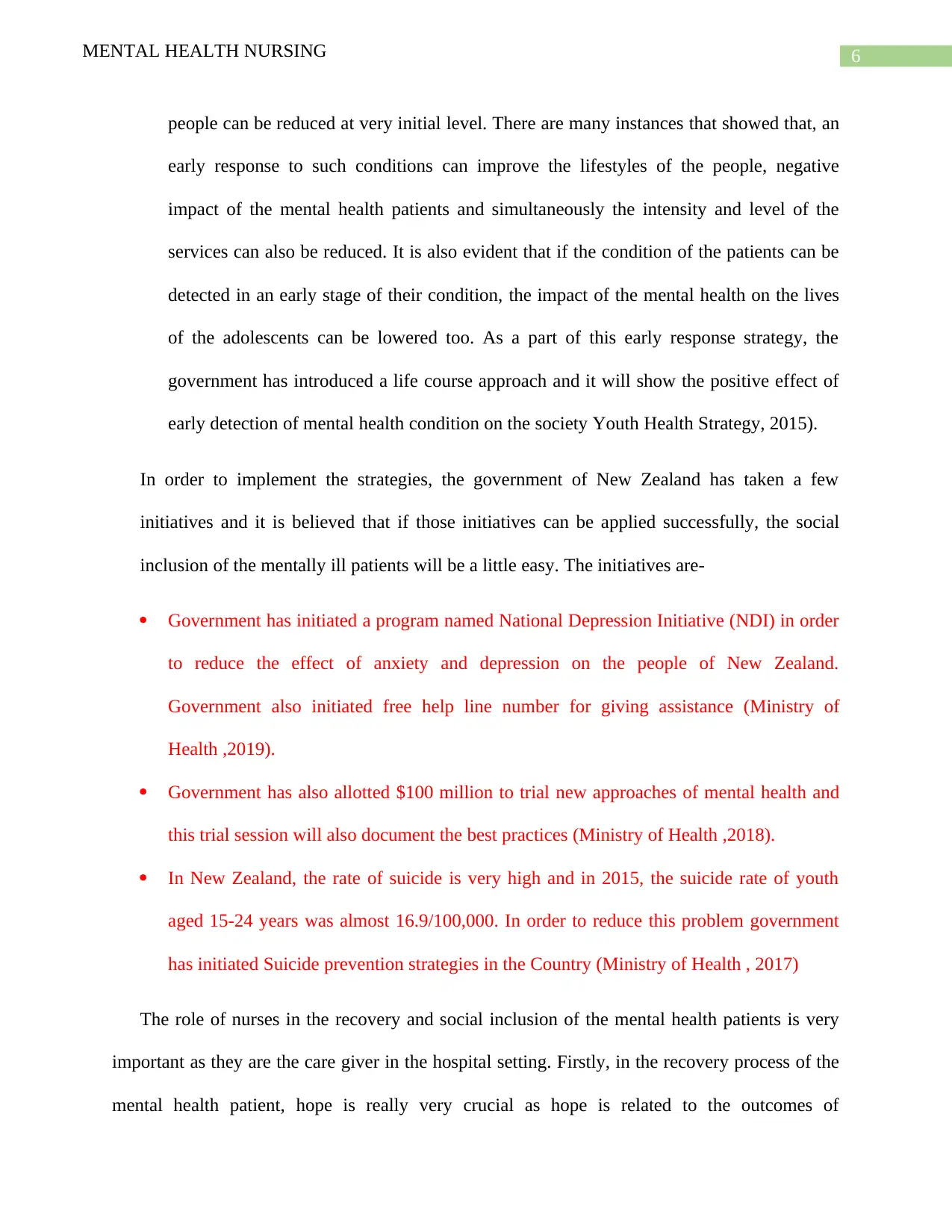
6MENTAL HEALTH NURSING
people can be reduced at very initial level. There are many instances that showed that, an
early response to such conditions can improve the lifestyles of the people, negative
impact of the mental health patients and simultaneously the intensity and level of the
services can also be reduced. It is also evident that if the condition of the patients can be
detected in an early stage of their condition, the impact of the mental health on the lives
of the adolescents can be lowered too. As a part of this early response strategy, the
government has introduced a life course approach and it will show the positive effect of
early detection of mental health condition on the society Youth Health Strategy, 2015).
In order to implement the strategies, the government of New Zealand has taken a few
initiatives and it is believed that if those initiatives can be applied successfully, the social
inclusion of the mentally ill patients will be a little easy. The initiatives are-
Government has initiated a program named National Depression Initiative (NDI) in order
to reduce the effect of anxiety and depression on the people of New Zealand.
Government also initiated free help line number for giving assistance (Ministry of
Health ,2019).
Government has also allotted $100 million to trial new approaches of mental health and
this trial session will also document the best practices (Ministry of Health ,2018).
In New Zealand, the rate of suicide is very high and in 2015, the suicide rate of youth
aged 15-24 years was almost 16.9/100,000. In order to reduce this problem government
has initiated Suicide prevention strategies in the Country (Ministry of Health , 2017)
The role of nurses in the recovery and social inclusion of the mental health patients is very
important as they are the care giver in the hospital setting. Firstly, in the recovery process of the
mental health patient, hope is really very crucial as hope is related to the outcomes of
people can be reduced at very initial level. There are many instances that showed that, an
early response to such conditions can improve the lifestyles of the people, negative
impact of the mental health patients and simultaneously the intensity and level of the
services can also be reduced. It is also evident that if the condition of the patients can be
detected in an early stage of their condition, the impact of the mental health on the lives
of the adolescents can be lowered too. As a part of this early response strategy, the
government has introduced a life course approach and it will show the positive effect of
early detection of mental health condition on the society Youth Health Strategy, 2015).
In order to implement the strategies, the government of New Zealand has taken a few
initiatives and it is believed that if those initiatives can be applied successfully, the social
inclusion of the mentally ill patients will be a little easy. The initiatives are-
Government has initiated a program named National Depression Initiative (NDI) in order
to reduce the effect of anxiety and depression on the people of New Zealand.
Government also initiated free help line number for giving assistance (Ministry of
Health ,2019).
Government has also allotted $100 million to trial new approaches of mental health and
this trial session will also document the best practices (Ministry of Health ,2018).
In New Zealand, the rate of suicide is very high and in 2015, the suicide rate of youth
aged 15-24 years was almost 16.9/100,000. In order to reduce this problem government
has initiated Suicide prevention strategies in the Country (Ministry of Health , 2017)
The role of nurses in the recovery and social inclusion of the mental health patients is very
important as they are the care giver in the hospital setting. Firstly, in the recovery process of the
mental health patient, hope is really very crucial as hope is related to the outcomes of
Paraphrase This Document
Need a fresh take? Get an instant paraphrase of this document with our AI Paraphraser
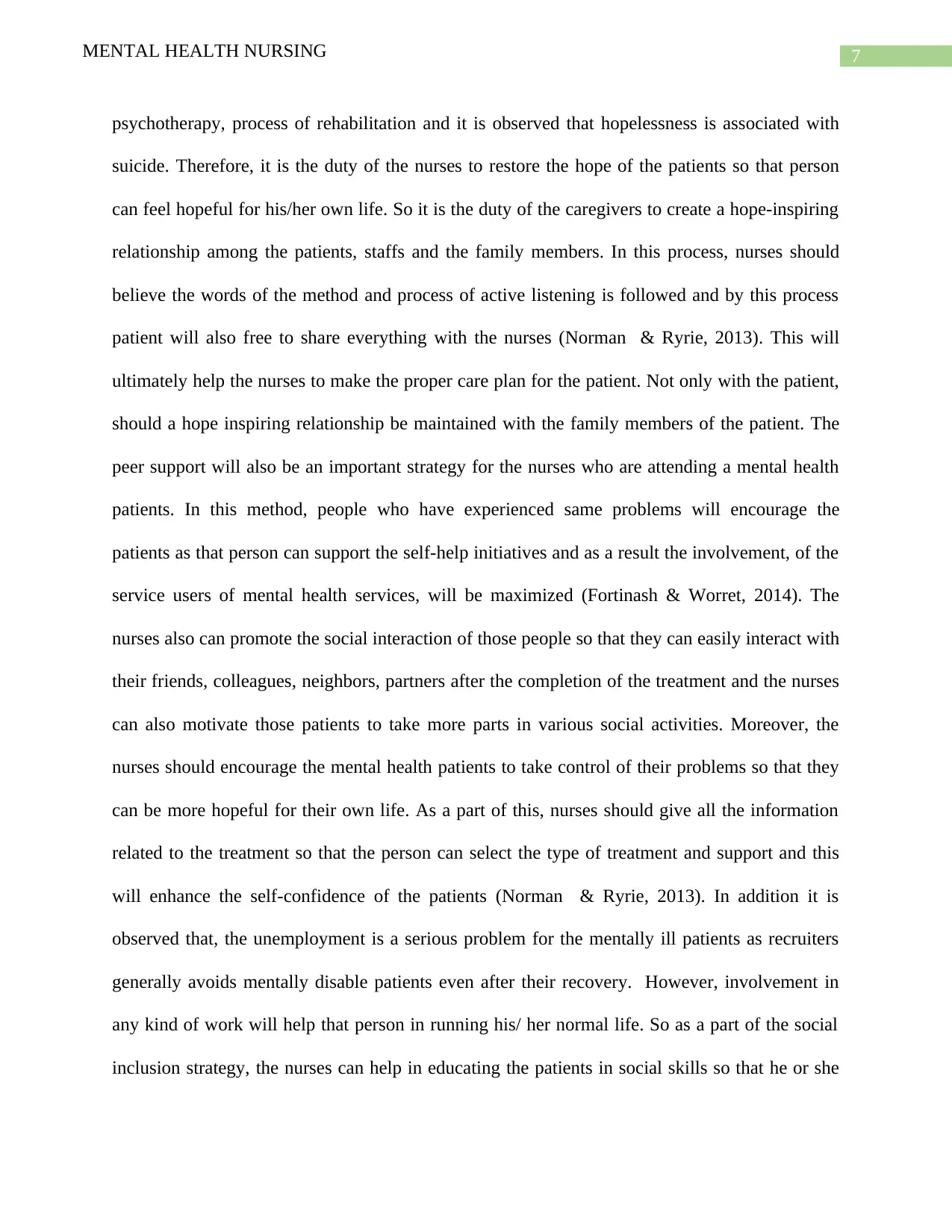
7MENTAL HEALTH NURSING
psychotherapy, process of rehabilitation and it is observed that hopelessness is associated with
suicide. Therefore, it is the duty of the nurses to restore the hope of the patients so that person
can feel hopeful for his/her own life. So it is the duty of the caregivers to create a hope-inspiring
relationship among the patients, staffs and the family members. In this process, nurses should
believe the words of the method and process of active listening is followed and by this process
patient will also free to share everything with the nurses (Norman & Ryrie, 2013). This will
ultimately help the nurses to make the proper care plan for the patient. Not only with the patient,
should a hope inspiring relationship be maintained with the family members of the patient. The
peer support will also be an important strategy for the nurses who are attending a mental health
patients. In this method, people who have experienced same problems will encourage the
patients as that person can support the self-help initiatives and as a result the involvement, of the
service users of mental health services, will be maximized (Fortinash & Worret, 2014). The
nurses also can promote the social interaction of those people so that they can easily interact with
their friends, colleagues, neighbors, partners after the completion of the treatment and the nurses
can also motivate those patients to take more parts in various social activities. Moreover, the
nurses should encourage the mental health patients to take control of their problems so that they
can be more hopeful for their own life. As a part of this, nurses should give all the information
related to the treatment so that the person can select the type of treatment and support and this
will enhance the self-confidence of the patients (Norman & Ryrie, 2013). In addition it is
observed that, the unemployment is a serious problem for the mentally ill patients as recruiters
generally avoids mentally disable patients even after their recovery. However, involvement in
any kind of work will help that person in running his/ her normal life. So as a part of the social
inclusion strategy, the nurses can help in educating the patients in social skills so that he or she
psychotherapy, process of rehabilitation and it is observed that hopelessness is associated with
suicide. Therefore, it is the duty of the nurses to restore the hope of the patients so that person
can feel hopeful for his/her own life. So it is the duty of the caregivers to create a hope-inspiring
relationship among the patients, staffs and the family members. In this process, nurses should
believe the words of the method and process of active listening is followed and by this process
patient will also free to share everything with the nurses (Norman & Ryrie, 2013). This will
ultimately help the nurses to make the proper care plan for the patient. Not only with the patient,
should a hope inspiring relationship be maintained with the family members of the patient. The
peer support will also be an important strategy for the nurses who are attending a mental health
patients. In this method, people who have experienced same problems will encourage the
patients as that person can support the self-help initiatives and as a result the involvement, of the
service users of mental health services, will be maximized (Fortinash & Worret, 2014). The
nurses also can promote the social interaction of those people so that they can easily interact with
their friends, colleagues, neighbors, partners after the completion of the treatment and the nurses
can also motivate those patients to take more parts in various social activities. Moreover, the
nurses should encourage the mental health patients to take control of their problems so that they
can be more hopeful for their own life. As a part of this, nurses should give all the information
related to the treatment so that the person can select the type of treatment and support and this
will enhance the self-confidence of the patients (Norman & Ryrie, 2013). In addition it is
observed that, the unemployment is a serious problem for the mentally ill patients as recruiters
generally avoids mentally disable patients even after their recovery. However, involvement in
any kind of work will help that person in running his/ her normal life. So as a part of the social
inclusion strategy, the nurses can help in educating the patients in social skills so that he or she
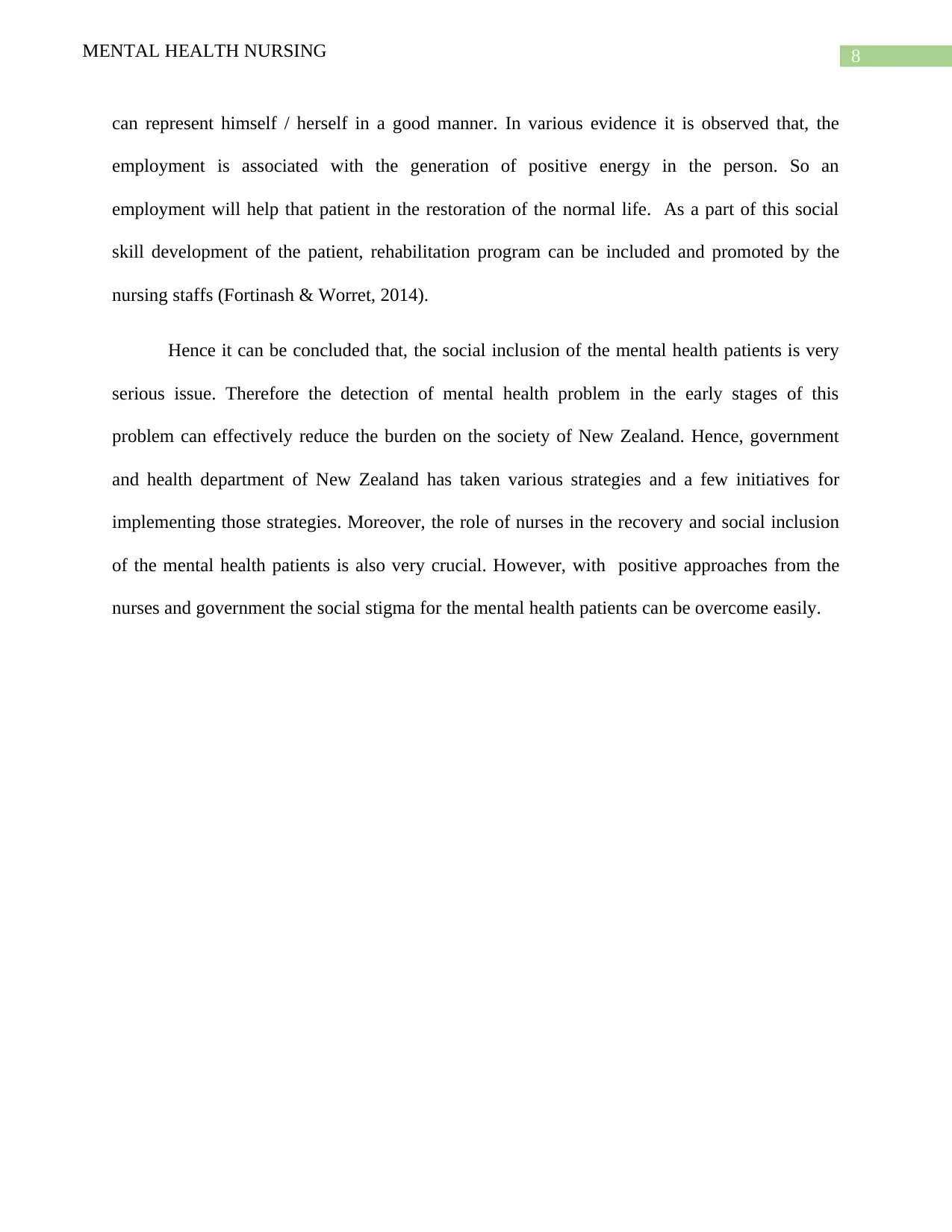
8MENTAL HEALTH NURSING
can represent himself / herself in a good manner. In various evidence it is observed that, the
employment is associated with the generation of positive energy in the person. So an
employment will help that patient in the restoration of the normal life. As a part of this social
skill development of the patient, rehabilitation program can be included and promoted by the
nursing staffs (Fortinash & Worret, 2014).
Hence it can be concluded that, the social inclusion of the mental health patients is very
serious issue. Therefore the detection of mental health problem in the early stages of this
problem can effectively reduce the burden on the society of New Zealand. Hence, government
and health department of New Zealand has taken various strategies and a few initiatives for
implementing those strategies. Moreover, the role of nurses in the recovery and social inclusion
of the mental health patients is also very crucial. However, with positive approaches from the
nurses and government the social stigma for the mental health patients can be overcome easily.
can represent himself / herself in a good manner. In various evidence it is observed that, the
employment is associated with the generation of positive energy in the person. So an
employment will help that patient in the restoration of the normal life. As a part of this social
skill development of the patient, rehabilitation program can be included and promoted by the
nursing staffs (Fortinash & Worret, 2014).
Hence it can be concluded that, the social inclusion of the mental health patients is very
serious issue. Therefore the detection of mental health problem in the early stages of this
problem can effectively reduce the burden on the society of New Zealand. Hence, government
and health department of New Zealand has taken various strategies and a few initiatives for
implementing those strategies. Moreover, the role of nurses in the recovery and social inclusion
of the mental health patients is also very crucial. However, with positive approaches from the
nurses and government the social stigma for the mental health patients can be overcome easily.
⊘ This is a preview!⊘
Do you want full access?
Subscribe today to unlock all pages.

Trusted by 1+ million students worldwide
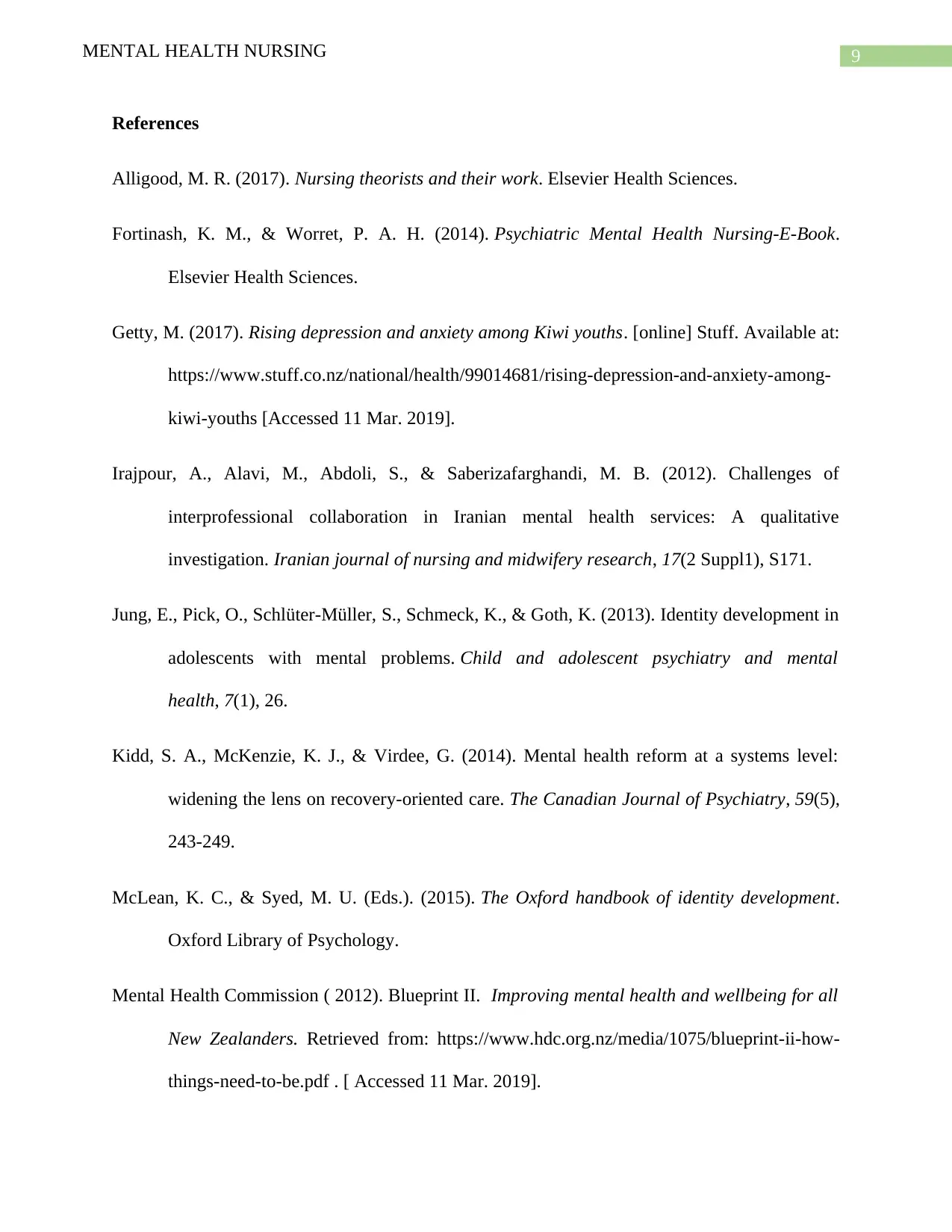
9MENTAL HEALTH NURSING
References
Alligood, M. R. (2017). Nursing theorists and their work. Elsevier Health Sciences.
Fortinash, K. M., & Worret, P. A. H. (2014). Psychiatric Mental Health Nursing-E-Book.
Elsevier Health Sciences.
Getty, M. (2017). Rising depression and anxiety among Kiwi youths. [online] Stuff. Available at:
https://www.stuff.co.nz/national/health/99014681/rising-depression-and-anxiety-among-
kiwi-youths [Accessed 11 Mar. 2019].
Irajpour, A., Alavi, M., Abdoli, S., & Saberizafarghandi, M. B. (2012). Challenges of
interprofessional collaboration in Iranian mental health services: A qualitative
investigation. Iranian journal of nursing and midwifery research, 17(2 Suppl1), S171.
Jung, E., Pick, O., Schlüter-Müller, S., Schmeck, K., & Goth, K. (2013). Identity development in
adolescents with mental problems. Child and adolescent psychiatry and mental
health, 7(1), 26.
Kidd, S. A., McKenzie, K. J., & Virdee, G. (2014). Mental health reform at a systems level:
widening the lens on recovery-oriented care. The Canadian Journal of Psychiatry, 59(5),
243-249.
McLean, K. C., & Syed, M. U. (Eds.). (2015). The Oxford handbook of identity development.
Oxford Library of Psychology.
Mental Health Commission ( 2012). Blueprint II. Improving mental health and wellbeing for all
New Zealanders. Retrieved from: https://www.hdc.org.nz/media/1075/blueprint-ii-how-
things-need-to-be.pdf . [ Accessed 11 Mar. 2019].
References
Alligood, M. R. (2017). Nursing theorists and their work. Elsevier Health Sciences.
Fortinash, K. M., & Worret, P. A. H. (2014). Psychiatric Mental Health Nursing-E-Book.
Elsevier Health Sciences.
Getty, M. (2017). Rising depression and anxiety among Kiwi youths. [online] Stuff. Available at:
https://www.stuff.co.nz/national/health/99014681/rising-depression-and-anxiety-among-
kiwi-youths [Accessed 11 Mar. 2019].
Irajpour, A., Alavi, M., Abdoli, S., & Saberizafarghandi, M. B. (2012). Challenges of
interprofessional collaboration in Iranian mental health services: A qualitative
investigation. Iranian journal of nursing and midwifery research, 17(2 Suppl1), S171.
Jung, E., Pick, O., Schlüter-Müller, S., Schmeck, K., & Goth, K. (2013). Identity development in
adolescents with mental problems. Child and adolescent psychiatry and mental
health, 7(1), 26.
Kidd, S. A., McKenzie, K. J., & Virdee, G. (2014). Mental health reform at a systems level:
widening the lens on recovery-oriented care. The Canadian Journal of Psychiatry, 59(5),
243-249.
McLean, K. C., & Syed, M. U. (Eds.). (2015). The Oxford handbook of identity development.
Oxford Library of Psychology.
Mental Health Commission ( 2012). Blueprint II. Improving mental health and wellbeing for all
New Zealanders. Retrieved from: https://www.hdc.org.nz/media/1075/blueprint-ii-how-
things-need-to-be.pdf . [ Accessed 11 Mar. 2019].
Paraphrase This Document
Need a fresh take? Get an instant paraphrase of this document with our AI Paraphraser
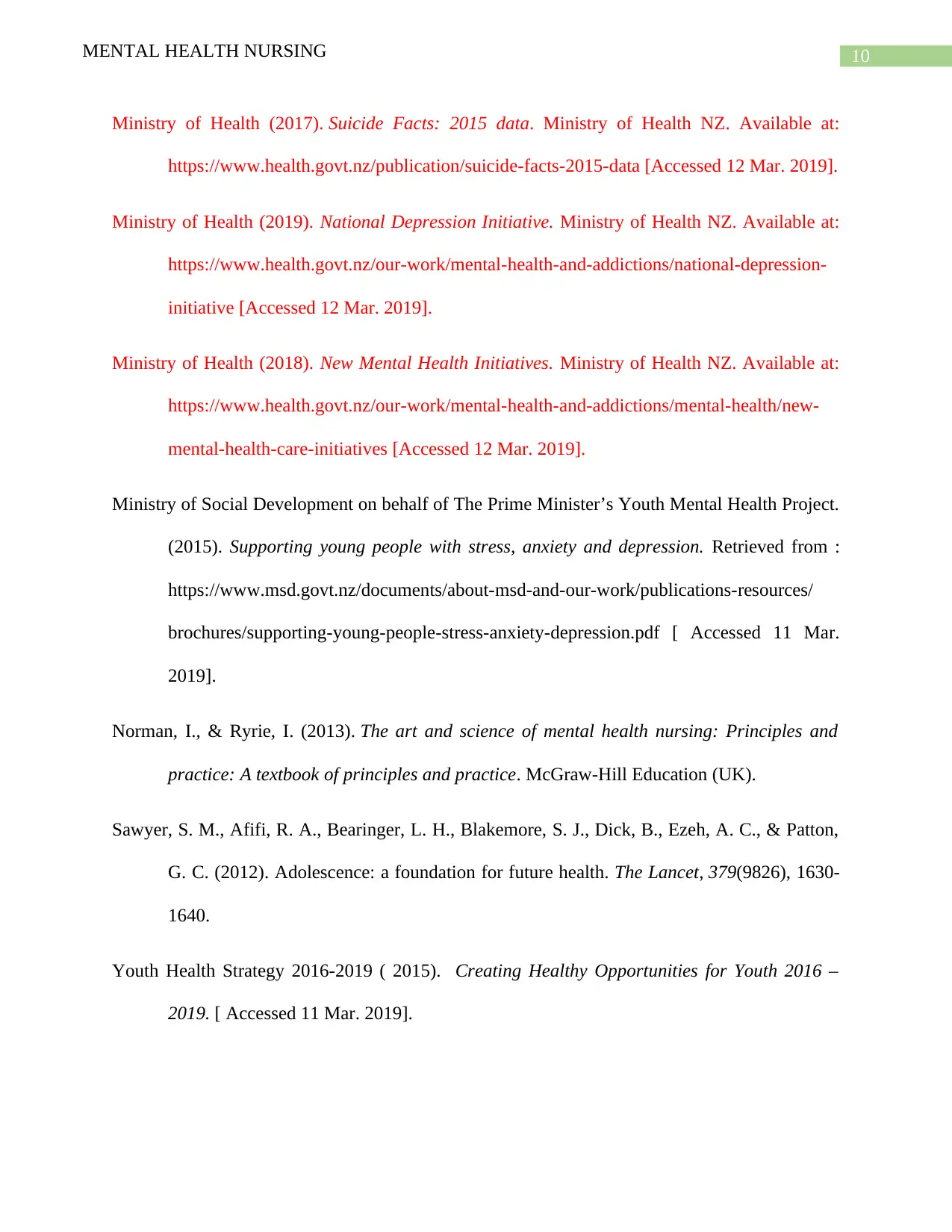
10MENTAL HEALTH NURSING
Ministry of Health (2017). Suicide Facts: 2015 data. Ministry of Health NZ. Available at:
https://www.health.govt.nz/publication/suicide-facts-2015-data [Accessed 12 Mar. 2019].
Ministry of Health (2019). National Depression Initiative. Ministry of Health NZ. Available at:
https://www.health.govt.nz/our-work/mental-health-and-addictions/national-depression-
initiative [Accessed 12 Mar. 2019].
Ministry of Health (2018). New Mental Health Initiatives. Ministry of Health NZ. Available at:
https://www.health.govt.nz/our-work/mental-health-and-addictions/mental-health/new-
mental-health-care-initiatives [Accessed 12 Mar. 2019].
Ministry of Social Development on behalf of The Prime Minister’s Youth Mental Health Project.
(2015). Supporting young people with stress, anxiety and depression. Retrieved from :
https://www.msd.govt.nz/documents/about-msd-and-our-work/publications-resources/
brochures/supporting-young-people-stress-anxiety-depression.pdf [ Accessed 11 Mar.
2019].
Norman, I., & Ryrie, I. (2013). The art and science of mental health nursing: Principles and
practice: A textbook of principles and practice. McGraw-Hill Education (UK).
Sawyer, S. M., Afifi, R. A., Bearinger, L. H., Blakemore, S. J., Dick, B., Ezeh, A. C., & Patton,
G. C. (2012). Adolescence: a foundation for future health. The Lancet, 379(9826), 1630-
1640.
Youth Health Strategy 2016-2019 ( 2015). Creating Healthy Opportunities for Youth 2016 –
2019. [ Accessed 11 Mar. 2019].
Ministry of Health (2017). Suicide Facts: 2015 data. Ministry of Health NZ. Available at:
https://www.health.govt.nz/publication/suicide-facts-2015-data [Accessed 12 Mar. 2019].
Ministry of Health (2019). National Depression Initiative. Ministry of Health NZ. Available at:
https://www.health.govt.nz/our-work/mental-health-and-addictions/national-depression-
initiative [Accessed 12 Mar. 2019].
Ministry of Health (2018). New Mental Health Initiatives. Ministry of Health NZ. Available at:
https://www.health.govt.nz/our-work/mental-health-and-addictions/mental-health/new-
mental-health-care-initiatives [Accessed 12 Mar. 2019].
Ministry of Social Development on behalf of The Prime Minister’s Youth Mental Health Project.
(2015). Supporting young people with stress, anxiety and depression. Retrieved from :
https://www.msd.govt.nz/documents/about-msd-and-our-work/publications-resources/
brochures/supporting-young-people-stress-anxiety-depression.pdf [ Accessed 11 Mar.
2019].
Norman, I., & Ryrie, I. (2013). The art and science of mental health nursing: Principles and
practice: A textbook of principles and practice. McGraw-Hill Education (UK).
Sawyer, S. M., Afifi, R. A., Bearinger, L. H., Blakemore, S. J., Dick, B., Ezeh, A. C., & Patton,
G. C. (2012). Adolescence: a foundation for future health. The Lancet, 379(9826), 1630-
1640.
Youth Health Strategy 2016-2019 ( 2015). Creating Healthy Opportunities for Youth 2016 –
2019. [ Accessed 11 Mar. 2019].
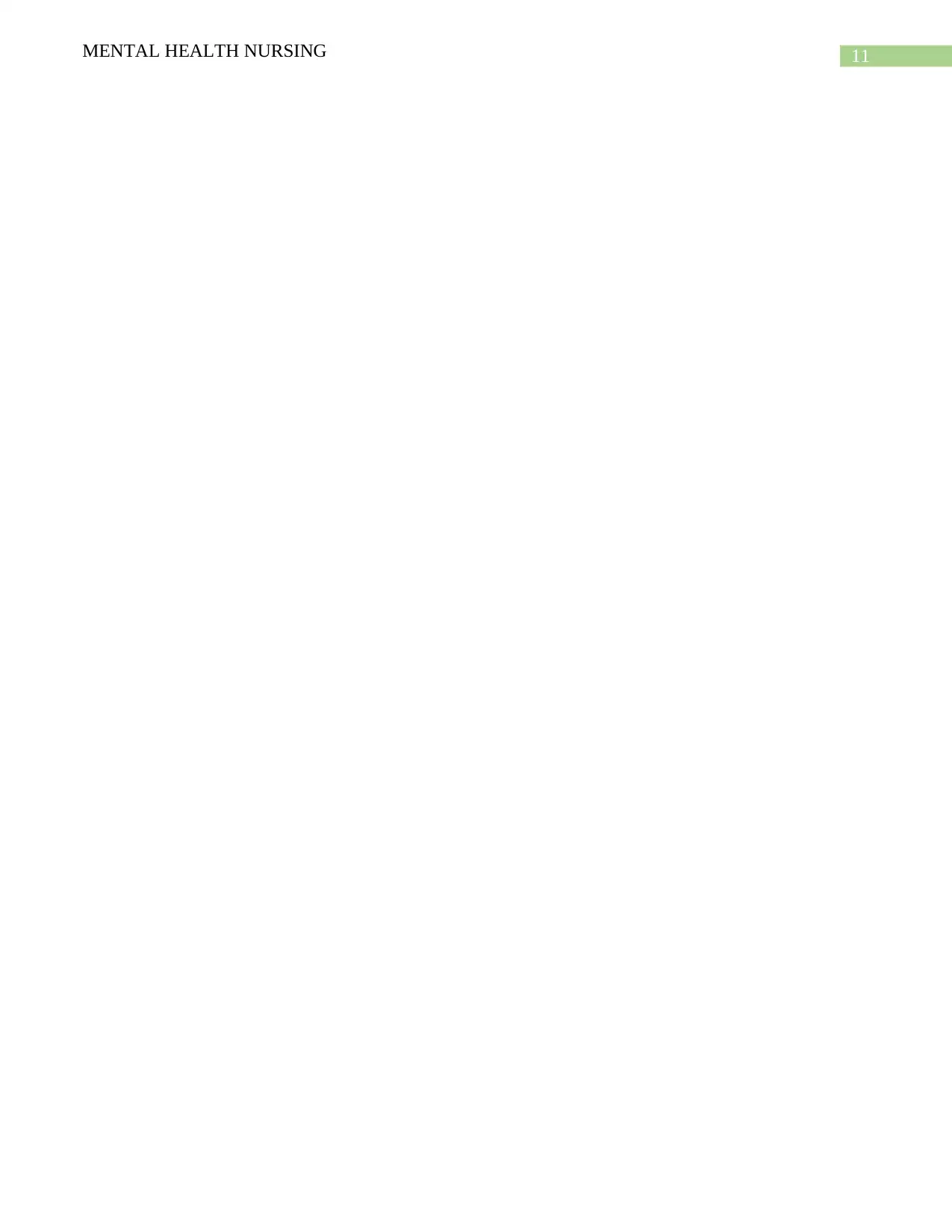
11MENTAL HEALTH NURSING
⊘ This is a preview!⊘
Do you want full access?
Subscribe today to unlock all pages.

Trusted by 1+ million students worldwide
1 out of 12
Related Documents
Your All-in-One AI-Powered Toolkit for Academic Success.
+13062052269
info@desklib.com
Available 24*7 on WhatsApp / Email
![[object Object]](/_next/static/media/star-bottom.7253800d.svg)
Unlock your academic potential
Copyright © 2020–2025 A2Z Services. All Rights Reserved. Developed and managed by ZUCOL.





